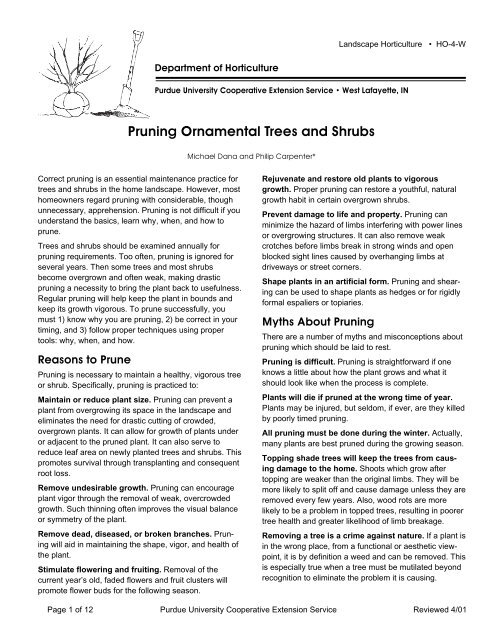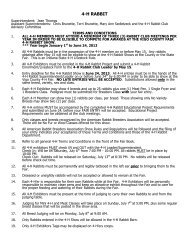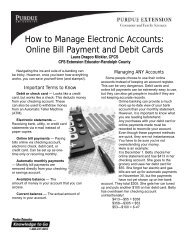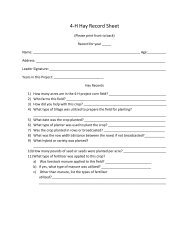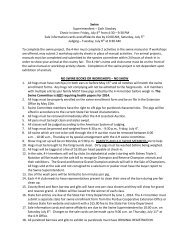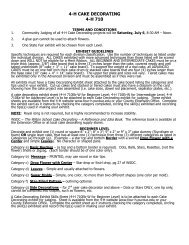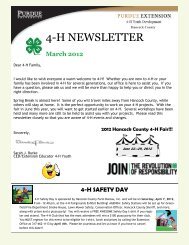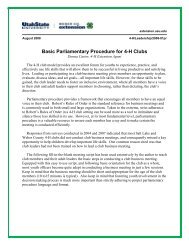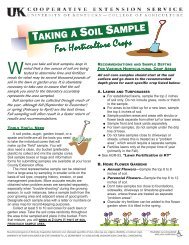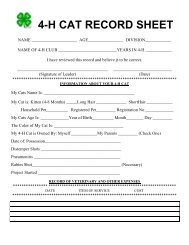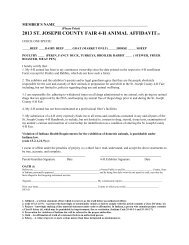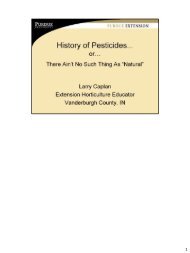Pruning Ornamental Trees and Shrubs
Pruning Ornamental Trees and Shrubs
Pruning Ornamental Trees and Shrubs
Create successful ePaper yourself
Turn your PDF publications into a flip-book with our unique Google optimized e-Paper software.
L<strong>and</strong>scape Horticulture • HO-4-W<br />
Department of Horticulture<br />
Purdue University Cooperative Extension Service • West Lafayette, IN<br />
<strong>Pruning</strong> <strong>Ornamental</strong> <strong>Trees</strong> <strong>and</strong> <strong>Shrubs</strong><br />
Michael Dana <strong>and</strong> Philip Carpenter*<br />
Correct pruning is an essential maintenance practice for<br />
trees <strong>and</strong> shrubs in the home l<strong>and</strong>scape. However, most<br />
homeowners regard pruning with considerable, though<br />
unnecessary, apprehension. <strong>Pruning</strong> is not difficult if you<br />
underst<strong>and</strong> the basics, learn why, when, <strong>and</strong> how to<br />
prune.<br />
<strong>Trees</strong> <strong>and</strong> shrubs should be examined annually for<br />
pruning requirements. Too often, pruning is ignored for<br />
several years. Then some trees <strong>and</strong> most shrubs<br />
become overgrown <strong>and</strong> often weak, making drastic<br />
pruning a necessity to bring the plant back to usefulness.<br />
Regular pruning will help keep the plant in bounds <strong>and</strong><br />
keep its growth vigorous. To prune successfully, you<br />
must 1) know why you are pruning, 2) be correct in your<br />
timing, <strong>and</strong> 3) follow proper techniques using proper<br />
tools: why, when, <strong>and</strong> how.<br />
Reasons to Prune<br />
<strong>Pruning</strong> is necessary to maintain a healthy, vigorous tree<br />
or shrub. Specifically, pruning is practiced to:<br />
Maintain or reduce plant size. <strong>Pruning</strong> can prevent a<br />
plant from overgrowing its space in the l<strong>and</strong>scape <strong>and</strong><br />
eliminates the need for drastic cutting of crowded,<br />
overgrown plants. It can allow for growth of plants under<br />
or adjacent to the pruned plant. It can also serve to<br />
reduce leaf area on newly planted trees <strong>and</strong> shrubs. This<br />
promotes survival through transplanting <strong>and</strong> consequent<br />
root loss.<br />
Remove undesirable growth. <strong>Pruning</strong> can encourage<br />
plant vigor through the removal of weak, overcrowded<br />
growth. Such thinning often improves the visual balance<br />
or symmetry of the plant.<br />
Remove dead, diseased, or broken branches. <strong>Pruning</strong><br />
will aid in maintaining the shape, vigor, <strong>and</strong> health of<br />
the plant.<br />
Stimulate flowering <strong>and</strong> fruiting. Removal of the<br />
current year’s old, faded flowers <strong>and</strong> fruit clusters will<br />
promote flower buds for the following season.<br />
Rejuvenate <strong>and</strong> restore old plants to vigorous<br />
growth. Proper pruning can restore a youthful, natural<br />
growth habit in certain overgrown shrubs.<br />
Prevent damage to life <strong>and</strong> property. <strong>Pruning</strong> can<br />
minimize the hazard of limbs interfering with power lines<br />
or overgrowing structures. It can also remove weak<br />
crotches before limbs break in strong winds <strong>and</strong> open<br />
blocked sight lines caused by overhanging limbs at<br />
driveways or street corners.<br />
Shape plants in an artificial form. <strong>Pruning</strong> <strong>and</strong> shearing<br />
can be used to shape plants as hedges or for rigidly<br />
formal espaliers or topiaries.<br />
Myths About <strong>Pruning</strong><br />
There are a number of myths <strong>and</strong> misconceptions about<br />
pruning which should be laid to rest.<br />
<strong>Pruning</strong> is difficult. <strong>Pruning</strong> is straightforward if one<br />
knows a little about how the plant grows <strong>and</strong> what it<br />
should look like when the process is complete.<br />
Plants will die if pruned at the wrong time of year.<br />
Plants may be injured, but seldom, if ever, are they killed<br />
by poorly timed pruning.<br />
All pruning must be done during the winter. Actually,<br />
many plants are best pruned during the growing season.<br />
Topping shade trees will keep the trees from causing<br />
damage to the home. Shoots which grow after<br />
topping are weaker than the original limbs. They will be<br />
more likely to split off <strong>and</strong> cause damage unless they are<br />
removed every few years. Also, wood rots are more<br />
likely to be a problem in topped trees, resulting in poorer<br />
tree health <strong>and</strong> greater likelihood of limb breakage.<br />
Removing a tree is a crime against nature. If a plant is<br />
in the wrong place, from a functional or aesthetic viewpoint,<br />
it is by definition a weed <strong>and</strong> can be removed. This<br />
is especially true when a tree must be mutilated beyond<br />
recognition to eliminate the problem it is causing.<br />
Page 1 of 12 Purdue University Cooperative Extension Service Reviewed 4/01
L<strong>and</strong>scape Horticulture • HO-4-W<br />
Most trees need pruning. Actually, mature trees<br />
seldom do. Young trees usually benefit because pruning<br />
helps in establishing the basic branch structure <strong>and</strong> in<br />
overcoming transplanting shock.<br />
Hedge shears are all you need to prune shrubs.<br />
Hedge shears are intended to prune hedges, only! Using<br />
them on shrubs not intended as hedge plants destroys<br />
the natural grace <strong>and</strong> beauty of the plants.<br />
Anyone with a pickup truck <strong>and</strong> a chain saw is a<br />
qualified pruner. Indiana has no licensure for tree<br />
pruners, thus some individuals doing pruning work may<br />
not be knowledgeable or skilled in proper techniques.<br />
Never hire someone who stops <strong>and</strong> tells you that your<br />
plants need pruning <strong>and</strong> that he will do it right away.<br />
Obtain references, <strong>and</strong> see their work first!<br />
All cut surfaces must be treated with tree paint.<br />
While long recommended, the evidence is conflicting on<br />
the use of tree paint. Largely, its use should be thought<br />
of as cosmetic, helping to hide light-colored scars.<br />
Times to Prune for Specific Purposes<br />
Timing of pruning is based on the flowering, fruiting, or<br />
growth habits of a plant, its tendency to “bleed,” <strong>and</strong> the<br />
fact that pruning usually stimulates a flush of re-growth.<br />
Most plants can be pruned at almost any time of year<br />
without jeopardizing basic survival. However, it is<br />
preferable to prune specific plants at specific points in<br />
the year.<br />
<strong>Pruning</strong> According to Season of Bloom<br />
<strong>Trees</strong> <strong>and</strong> shrubs that flower before the end of June<br />
should be pruned immediately after flowering. Flower<br />
buds develop during the previous season’s growth, thus,<br />
the flowers for the current year’s bloom developed last<br />
year <strong>and</strong> overwintered in the bud. If pruned before spring<br />
flowering, the flower buds will be removed, thus eliminating<br />
flowering. Table 1 shows examples of plants which<br />
should be pruned after flowering.<br />
Other trees <strong>and</strong> shrubs, those which flower after the end<br />
of June, should be pruned in winter or early spring<br />
before new growth starts. These plants develop flower<br />
buds during the spring of the flowering season. Examples<br />
of plants of this type are shown in Table 2.<br />
Certain plants may be lightly pruned both before <strong>and</strong><br />
after flowering. This often increases flower <strong>and</strong> fruit<br />
production, <strong>and</strong> several may produce a second bloom<br />
during the year. Table 3 shows examples of this plant<br />
type.<br />
In any of the foregoing cases, the timing of pruning is<br />
based on common sense to maximize flowering of a<br />
plant which was planted for its flowers. If your pruning is<br />
timed such that flowering is sacrificed, it will not be<br />
detrimental to the plant’s survival. It will simply mean a<br />
loss of one season’s floral display.<br />
Table 1. Spring-flowering trees <strong>and</strong> shrubs which should be<br />
pruned after flowering.<br />
Scientific name<br />
Amelanchier<br />
Berberis<br />
Calycanthus<br />
Caragana<br />
Celastrus<br />
Cercis<br />
Chaenomeles<br />
Chionanthus<br />
Cornus florida<br />
Cornus kousa<br />
Cornus mas<br />
Cotinus coggygria<br />
Cotoneaster<br />
Crataegus<br />
Deutzia<br />
Euonymus<br />
Forsythia<br />
Kalmia latifolia<br />
Kolkwitzia amabilis<br />
Laburnum<br />
Ligustrum<br />
Lindera<br />
Lonicera<br />
Magnolia<br />
Malus<br />
Philadelphus<br />
Pieris<br />
Prunus<br />
Pyracantha<br />
Rhododendron<br />
Rhodotypos sc<strong>and</strong>ens<br />
Ribes<br />
Rosa<br />
Sorbus<br />
Spiraea thunbergii<br />
Spiraea x vanhouttei<br />
Styrax japonica<br />
Syringa<br />
Viburnum<br />
Weigela<br />
Wisteria<br />
Common name<br />
Shadblow<br />
Barberry<br />
Sweetshrub<br />
Peashrub<br />
Bittersweet<br />
Redbud<br />
Flowering quince<br />
Fringetree<br />
Flowering dogwood<br />
Kousa dogwood<br />
Cornelian cherry<br />
Smoketree<br />
Cotoneaster<br />
Hawthorn<br />
Deutzia<br />
Winged spindle tree<br />
Forsythia<br />
Mountain laurel<br />
Beautybush<br />
Laburnum<br />
Privet<br />
Spicebush<br />
Honeysuckle<br />
Magnolia<br />
Crabapple<br />
Mock orange<br />
Andromeda<br />
Flowering cherry <strong>and</strong> plum<br />
Firethorn<br />
Rhododendron <strong>and</strong> Azalea<br />
Black jetbead<br />
Currant<br />
Climbers <strong>and</strong> shrub roses<br />
Mountain ash<br />
Thunberg spirea<br />
Vanhoutte spirea<br />
Japanese snowball<br />
Lilac<br />
Viburnum<br />
Weigela<br />
Wisteria<br />
Page 2 of 12 Purdue University Cooperative Extension Service Reviewed 4/01
L<strong>and</strong>scape Horticulture • HO-4-W<br />
<strong>Pruning</strong> to Maximize Fruiting Display<br />
<strong>Shrubs</strong> or trees that are prized for their fruit should be<br />
pruned after the fruit drops or is eaten by wildlife.<br />
Although they may flower early in the season, the fruit<br />
should be allowed to develop. After the fruit has lost its<br />
appeal, then prune. Examples of plants in this group are<br />
certain viburnums <strong>and</strong> hawthorns.<br />
<strong>Pruning</strong> Needle (Coniferous) Evergreens<br />
To promote a compact plant, coniferous evergreens can<br />
be pruned in late spring as the new branches elongate,<br />
but before they become stiff. Otherwise, they, like<br />
broadleaved evergreens, can be pruned whenever the<br />
wood is not frozen. However, coniferous types will<br />
generally not develop new shoots on older wood, so it<br />
isn’t advisable to cut back beyond the living foliage<br />
portion of the branches.<br />
<strong>Pruning</strong> <strong>Trees</strong> Known as “Bleeders”<br />
Some deciduous trees have an exceptionally heavy sap<br />
flow in the early spring. If cuts are made then, the trees<br />
will “bleed.” While this sap loss does not injure the tree, it<br />
can be objectionable aesthetically <strong>and</strong> cause problems<br />
for pedestrians, automobiles, etc., passing underneath.<br />
“Bleeding” can be avoided by pruning in mid-summer or<br />
late fall. Maple, birch, dogwood, elm, walnut, <strong>and</strong><br />
yellowwood are examples of trees best treated this way.<br />
<strong>Pruning</strong> in Anticipation of Growth Stimulation<br />
In general, except for the cases already cited, the best<br />
time to prune is when the plant will recover the fastest.<br />
Severe pruning should be done just before regrowth<br />
starts in the spring so bare stubs will be hidden quickly.<br />
<strong>Pruning</strong> in late summer should be avoided since it<br />
stimulates succulent growth which may not harden<br />
sufficiently to avoid winter dieback. Storm-damaged<br />
plants should be pruned as soon after the damage<br />
occurs as possible.<br />
Tools for <strong>Pruning</strong><br />
Proper pruning requires proper tools, employing correct<br />
methods, <strong>and</strong> applying the methods accurately to the<br />
appropriate plant. Tools should be of the highest quality<br />
you can afford, <strong>and</strong> they should be sharp. Keep them in<br />
good condition by lubricating regularly, cleaning to<br />
prevent rust, <strong>and</strong> only using them for their intended<br />
function. (See Fig. 1 for examples of common pruning<br />
tools.)<br />
Table 2. Summer-flowering trees <strong>and</strong> shrubs which should be<br />
pruned before spring growth begins.<br />
Table 3. <strong>Trees</strong> <strong>and</strong> shrubs which may be pruned both before<br />
<strong>and</strong> after bloom.<br />
Scientific name<br />
Common name<br />
Scientific name<br />
Common name<br />
Abelia x gr<strong>and</strong>iflora<br />
Acanthopanax<br />
Albizia julibrissin<br />
Buddleia davidii<br />
Callicarpa<br />
Hibiscus syriacus<br />
Hydrangea arborescens<br />
Hydrangea paniculata<br />
‘Gr<strong>and</strong>iflora’<br />
Hypericum<br />
Koelreuteria paniculata<br />
Magnolia virginiana<br />
Rhus<br />
Rosa cvs.<br />
Sorbaria<br />
Stewartia<br />
Symphoricarpos<br />
Glossy abelia<br />
Aralia<br />
Silk tree<br />
Butterflybush<br />
Beautyberry<br />
Shrub-althea<br />
Smooth hydrangea<br />
Pee Gee hydrangea<br />
St. Johnswort<br />
Goldenrain tree<br />
Sweet bay<br />
Sumac<br />
Hybrid tea roses<br />
False-spirea<br />
Stewartia<br />
Snowberry, Coralberry<br />
Cornus sericea<br />
Cotoneaster apiculatus<br />
Cotoneaster divaricatus<br />
Cotoneaster multiflorus<br />
Mahonia aquifolium<br />
Spiraea x bumalda<br />
Symphoricarpos albus<br />
Symphoricarpos x chenaultii<br />
Weigela<br />
Red-osier dogwood<br />
Cranberry cotoneaster<br />
Spreading cotoneaster<br />
Many-flowered cotoneaster<br />
Oregon hollygrape<br />
Anthony Waterer <strong>and</strong><br />
Froebel spirea<br />
Snowberry<br />
Chenault coralberry<br />
Weigela<br />
Page 3 of 12 Purdue University Cooperative Extension Service Reviewed 4/01
L<strong>and</strong>scape Horticulture • HO-4-W<br />
Figure 1. Examples of common pruning tools.<br />
H<strong>and</strong> shears (for branches up to 1/4'’ diameter)<br />
Both scissors <strong>and</strong> blade/anvil types are available in 6-9"<br />
sizes. Scissor type cuts more closely, while anvil type<br />
allows the cutting of slightly larger branches.<br />
Pole pruners (for branches beyond arm’s reach)<br />
Either a pruning head with rope action or a saw can be<br />
mounted on a pole pruner. A “take apart” h<strong>and</strong>le makes<br />
storage easier. A metal h<strong>and</strong>le pole pruner is not safe for<br />
use near utility lines.<br />
Lopping shears (for branches up to 1-1/2'’ diameter)<br />
Scissors <strong>and</strong> blade/anvil types each have 16-30" h<strong>and</strong>les.<br />
Strong but light-weight h<strong>and</strong>les are critical.<br />
Hedge shears (for clipping new growth into formal<br />
shapes)<br />
Power <strong>and</strong> h<strong>and</strong> types are available in 6-18" blades. These<br />
shears are not useful for pruning large branches or for any<br />
pruning which is intended to maintain a plant’s natural<br />
appearance.<br />
<strong>Pruning</strong> saws (for branches over 1'’ diameter)<br />
<strong>Pruning</strong> saws are characterized by coarse teeth to prevent gumming. Most cut on the pull stroke for easier, safer use. Chain<br />
saws are dangerous to use for pruning. They are best used for cutting up limbs already pruned or for removing dead plants.<br />
Basic Procedures in <strong>Pruning</strong><br />
There are three relatively simple techniques basic to all<br />
pruning situations.<br />
Pinching is usually done by h<strong>and</strong>, <strong>and</strong> this is a good way<br />
to control plant size. (See Fig. 2.)<br />
Thinning completely removes some branches back to a<br />
main branch, trunk, or soil line. Do not cut into the<br />
branch collar when making a thinning cut back to a trunk<br />
or main branch; that is, do not cut so near the trunk that<br />
you cut through the area at the base of the limb adjacent<br />
to the main trunk, known as the branch collar. Such a cut<br />
allows for infection to spread into the part of the plant<br />
you wish to keep. Cut only the branch to be removed,<br />
about 1/2"-2" from the main trunk (depending on age).<br />
(See Fig. 3.)<br />
Heading back involves shortening branches back to a<br />
good bud or lateral branch. A proper heading back cut<br />
should not leave a stub. Make your cut about 1/4" above<br />
an active bud or lateral branch. (See Fig. 4.)<br />
The Wound Dressing Question<br />
Wound dressing or tree paint is not essential; recent<br />
research has pointed out that tree paint or wound<br />
dressing is not as advantageous as previously thought.<br />
Dressings may actually harbor disease organisms rather<br />
than exclude them. It has also been determined that<br />
wound dressing slows the wound callusing (often called<br />
healing) process, rather than speeding it up. The only<br />
reason for painting a pruning cut is a cosmetic one.<br />
When appearance is a factor, the painting should be<br />
done with latex paint. A good, clean unpainted pruning<br />
cut, while perhaps unsightly at first, will probably callus<br />
faster than a painted one. On the basis of tree health<br />
alone, pruning cuts should not be painted.<br />
Page 4 of 12 Purdue University Cooperative Extension Service Reviewed 4/01
L<strong>and</strong>scape Horticulture • HO-4-W<br />
Figure 2. Pinching out growing tips of shoots.<br />
Figure 4. Heading back for size control<br />
Figure 3. Thinning of limbs back to a main trunk.<br />
too long a stub correct cut too close a cut<br />
Basic Safety Rules for <strong>Pruning</strong><br />
1. Call in a professional for large trees or for jobs you<br />
don't have the equipment for.<br />
2. Keep all equipment sharp <strong>and</strong> in good repair.<br />
3. Use equipment only for the job it was designed to do.<br />
4. Be conscious of electric lines when pruning near them.<br />
5. If a power line is touching a tree limb, call the power<br />
company fast <strong>and</strong> stay clear of the tree.<br />
6. Never climb a tree without a safety rope, with or<br />
without a ladder.<br />
7. Keep your fingers clear when using h<strong>and</strong> clippers.<br />
8. Use care in h<strong>and</strong>ling pruned limbs <strong>and</strong> brush to avoid<br />
eye injury.<br />
Page 5 of 12 Purdue University Cooperative Extension Service Reviewed 4/01
L<strong>and</strong>scape Horticulture • HO-4-W<br />
Procedures for <strong>Pruning</strong><br />
Specific <strong>Trees</strong> <strong>and</strong> <strong>Shrubs</strong><br />
Deciduous <strong>Shrubs</strong> <strong>and</strong> <strong>Trees</strong><br />
Always allow a shrub or tree to develop its natural<br />
shape, except when special effects are desirable, such<br />
as for hedges. “Haircut” pruning should be avoided.<br />
Perfectly sheared globes <strong>and</strong> squares make a mockery<br />
of the plant’s natural form <strong>and</strong> beauty. (See Fig. 5.)<br />
Instead, use the thinning technique on both shrubs <strong>and</strong><br />
trees. Cut the branches at different lengths, 1/4" above<br />
an active bud. Remove twigs or branches selectively <strong>and</strong><br />
thus reduce overcrowding. Some stems should also be<br />
removed at ground level. The length of new shoots<br />
should be reduced 1/3 to 1/2 of their length, which<br />
induces side shoots to develop.<br />
Cutting above a bud prevents dieback of the stem <strong>and</strong><br />
encourages a new branch to develop from the bud. The<br />
haircut technique causes a dense growth at the ends of<br />
the pruned branches which shades the rest of the plant,<br />
thus causing the plant to eventually develop a leggy<br />
appearance. If a shrub develops a weak, dense growth,<br />
thin out many of the smaller branches <strong>and</strong> twigs. This<br />
promotes the vigorous growth of the remaining<br />
branches. Also remove branches which tend to rub<br />
against one another, opening wounds for the entrance of<br />
disease.<br />
Figure 5. “Haircut” pruning should be avoided.<br />
Always remove dead, damaged, or diseased branches<br />
<strong>and</strong> limbs from established plants as well as newly<br />
planted trees <strong>and</strong> shrubs. The plant should then develop<br />
new, stronger growth, free of diseases. Also, remove<br />
dead flower branches, dead flowers, <strong>and</strong> old fruit stocks<br />
as soon as the flowers have wilted or the fruit has<br />
dropped. This stimulates new growth <strong>and</strong> helps to make<br />
a stronger tree or shrub. It also encourages plants such<br />
as rhododendrons to produce more flower buds for next<br />
season.<br />
Evergreen <strong>Shrubs</strong> <strong>and</strong> <strong>Trees</strong><br />
With evergreen shrubs, avoid shearing to artificial<br />
shapes. If the evergreen plant has a soft, feathery<br />
appearance, do not cut it square or make a round shrub<br />
out of it. Prune using the thinning technique, thus<br />
keeping the natural shape of the evergreen. Remember,<br />
the non-green portion of needle-leaved evergreen<br />
branches does not normally put out new branches.<br />
Therefore do not cut branches back to the old wood.<br />
Reduce new growth annually, <strong>and</strong> when removing the<br />
larger branches for thinning, cut close to the main trunk,<br />
leaving no stubs. Heavy thinning is needed only every<br />
few years.<br />
With certain evergreens such as yews (Taxus), a new<br />
flush of growth will occur in the early fall. Head back<br />
these long shoots to keep the plants in shape.<br />
Broadleafed evergreen shrubs are pruned in the same<br />
manner as narrowleafed evergreens, by thinning <strong>and</strong><br />
heading back. Light pruning every year is preferred, but<br />
heavy pruning every three years is acceptable. Rhododendron<br />
species benefit from removal of flower heads<br />
immediately after flowering. Most types, such as hollies,<br />
pyracantha, azaleas, <strong>and</strong> euonymus, can be cut back<br />
severely, but avoid cutting all the way to the ground.<br />
Holly trees may be pruned at Christmas time.<br />
To thicken the new growth of coniferous trees such as<br />
pines, spruce, or fir, pinch out 1/2 of the c<strong>and</strong>le (the new<br />
growth) when it is approximately 2" long in the spring. Do<br />
not use shears, since they damage the needles that are<br />
around the c<strong>and</strong>le <strong>and</strong> cause the cut edges to turn<br />
brown. This gives the tree an unsightly appearance. Do<br />
not top or remove the central leader, if the natural growth<br />
habit of the tree is desired. (See Fig. 6.)<br />
If the terminal of a pine or spruce has been lost, it is<br />
necessary to aid the plant in growing a new terminal<br />
shoot. Without assistance, a single terminal will probably<br />
not be re-established, <strong>and</strong> multiple leaders will result. To<br />
form a new terminal, bend one of the youngest lateral<br />
branches near the terminal into an upright position.<br />
Page 6 of 12 Purdue University Cooperative Extension Service Reviewed 4/01
L<strong>and</strong>scape Horticulture • HO-4-W<br />
Figure 6. Pinch pine c<strong>and</strong>les when new growth is about 2<br />
inches long. Remove 1/2 of the c<strong>and</strong>le.<br />
Figure 7B. The lateral branch can also be secured with a<br />
stake.<br />
Secure it to the dead terminal stub or insert a stake for<br />
rigidity. After a season, this branch will take over as a<br />
terminal shoot. Once this occurs, remove the stub or<br />
stake, <strong>and</strong> the plant will resume its characteristic growth<br />
habit. (See Fig. 7A <strong>and</strong> B.)<br />
Figure 7A. Replace a lost terminal leader by tying a lateral<br />
branch in a vertical position <strong>and</strong> securing it to the stub of the<br />
dead terminal.<br />
Newly Transplanted <strong>Trees</strong><br />
In the digging process at transplanting time, bare root<br />
trees <strong>and</strong> shrubs suffer root damage as well as a loss of<br />
roots. To compensate for this loss of roots, the leaf area<br />
of the plant should be reduced by 1/3 to reduce water<br />
loss due to transpiration <strong>and</strong> evaporation. The natural<br />
form of newly planted trees <strong>and</strong> shrubs should be<br />
preserved by thinning. Remove branches <strong>and</strong> parts of<br />
branches by cutting at different lengths as previously<br />
described. (See Fig. 8.)<br />
Figure 8. Use the thinning technique to remove 1/3 of the<br />
leaf area of newly-planted trees.<br />
Page 7 of 12 Purdue University Cooperative Extension Service Reviewed 4/01
L<strong>and</strong>scape Horticulture • HO-4-W<br />
When the tree is approximately 2 years old, establish<br />
good branch spacing (See Fig. 9). Branches should<br />
arise alternately from the main stem <strong>and</strong> be well-spaced<br />
radially. This will allow stronger limbs to develop. Select<br />
branches with the widest angles in the crotch. The wider<br />
this angle, the stronger the limb attachment. (See Fig.<br />
10.)<br />
On most shade trees, the top-most growing point is<br />
critical in achieving a form typical of the species. This<br />
growing point is called the central leader, <strong>and</strong> there<br />
should be only one. It should not be cut.<br />
Figure 9. Establish alternate branching.<br />
Large <strong>Trees</strong><br />
Proper pruning also helps to prevent injury <strong>and</strong> damage<br />
to life <strong>and</strong> property. This usually involves the removal of<br />
large branches or limbs from trees. Where tree limbs are<br />
near power lines, call the power company <strong>and</strong> ask them<br />
to remove them. Do not try to remove tree limbs from<br />
power lines yourself.<br />
Low-hanging branches may cause injury to individuals<br />
mowing the lawn or walking on the street. Also,<br />
branches sometimes rub against the house <strong>and</strong> roof. To<br />
remove the branches that are over 1" in diameter, use<br />
the double cut method. If the double cut method is not<br />
used, the branch will tear <strong>and</strong> splinter the trunk. This<br />
removes a large portion of the bark, causing a large<br />
wound which calluses with difficulty <strong>and</strong> may further<br />
result in permanent damage to the tree. (See Fig. 11.)<br />
To double cut, first cut halfway on the underside of the<br />
limb (about one foot from the tree trunk). Then (several<br />
inches further out) make a second cut through on the<br />
upper part of the limb (See Fig. 12). When the branch is<br />
removed, there is no splintering of the main tree trunk.<br />
Then remove the stub by conventional methods, taking<br />
care not to cut into the collar. (See “General <strong>Pruning</strong><br />
Procedures”).<br />
Figure 10. Remove branches with a narrow angle or weak<br />
crotch (A), <strong>and</strong> leave wide-angled or strong crotches (B).<br />
Beware of rejuvenation techniques sometimes used on<br />
large old trees. Homeowners are sometimes “conned”<br />
into having the tops of old trees completely cut back,<br />
leaving only the stubs. These stubs eventually decay.<br />
Also, since the tree is in such a weakened condition, it<br />
may die prematurely. If you have large limbs that need to<br />
be removed, secure the professional services of an<br />
arborist. An arborist can drop work a tree, that is, lower<br />
Figure 11. Failure to use the double cut method can result<br />
in trunk damage <strong>and</strong> bark stripping.<br />
Page 8 of 12 Purdue University Cooperative Extension Service Reviewed 4/01
L<strong>and</strong>scape Horticulture • HO-4-W<br />
Figure 12. Double cut method for large limb removal.<br />
Avoid cutting through<br />
the branch collar.<br />
the height, by removing limbs that are causing problems.<br />
When completed, the tree will still retain the beauty of its<br />
natural shape. Remember, a tree that has a trunk<br />
diameter of 20-24 inches may be worth up to $10,000 on<br />
a replacement value scale. Therefore, if you have a<br />
large, valuable tree, secure the services of a professional<br />
arborist.<br />
Old, Overgrown <strong>Shrubs</strong><br />
Another aspect of pruning is the renewal of declining<br />
shrubs. In renewal pruning, remove one-third of the old,<br />
mature stems per season. These large, old branches are<br />
removed at the ground level. Leave the young vigorous<br />
branches. The water sprouts that develop should be cut<br />
back to different lengths <strong>and</strong> encouraged to develop into<br />
strong branches for the shrubs by the thinning process.<br />
(See Fig. 13.)<br />
Figure 13. Renewal pruning.<br />
First year - A. Large old bush. B. Remove 1/3 of old branches at ground<br />
level. C. Growth at end of first season.<br />
Second year - D. Use thinning technique to remove 1/3 of old branches <strong>and</strong><br />
to cut back new growth. E. Growth at end of second season.<br />
Third year - F. Use thinning technique to remove remaining old branches <strong>and</strong> to<br />
cut back new growth, G. Growth at end of third season (rejuvenated shrub).<br />
Page 9 of 12 Purdue University Cooperative Extension Service Reviewed 4/01
L<strong>and</strong>scape Horticulture • HO-4-W<br />
Lilac wood often is more than 3 years old before it<br />
flowers. Therefore, large, overgrown lilac bushes can<br />
gradually be cut back over a period of years, but do not<br />
remove all the old flowering wood until the new growth<br />
begins to flower. Then the bush will flower every year<br />
<strong>and</strong> will not have any barren years.<br />
If it is essential to immediately reduce the size of a<br />
shrub, rejuvenation pruning is appropriate for some<br />
species (Table 4). Cut back the entire top of the plant to<br />
the ground line. Many new shoots will grow from the<br />
base, <strong>and</strong> they will require thinning. As much as 3/4 of<br />
the new growth should be removed, depending on the<br />
species. (See Fig. 14.)<br />
Some plants frequently suffer winter die back of all<br />
above-ground stems. These may be safely rejuvenation<br />
pruned to produce rapid new growth. These plants are<br />
considered to be usefully winter hardy. They can be<br />
used for l<strong>and</strong>scaping purposes similar to an herbaceous<br />
perennial, even though severe rejuvenation pruning<br />
often is necessary.<br />
Hedges, Espaliers, <strong>and</strong> Topiary<br />
Plants are occasionally sheared to unnatural shapes.<br />
Hedges as barriers are the most common example.<br />
However, hedges are often improperly pruned, with the<br />
top trimmed flat <strong>and</strong> the sides sloped inward so that the<br />
base is more narrow than the top. This shades the lower<br />
portion of the hedge, preventing dense leaf growth.<br />
Thus, the plants become leggy, the hedge becomes<br />
straggly, <strong>and</strong> the screening function is not achieved. In<br />
proper hedge shearing, the top is shaped more narrow<br />
Table 4. L<strong>and</strong>scape plants which may be rejuvenation pruned<br />
(completely cut back to the ground).<br />
Scientific name<br />
Buddleia davidii<br />
Forsythia<br />
Hibiscus syriacus<br />
Hydrangea arborescens ‘Gr<strong>and</strong>iflora’<br />
Hydrangea quercifolia<br />
Ligustrum vulgare<br />
Lonicera<br />
Spiraea<br />
Syringa<br />
Common name<br />
Orange-eye<br />
butterflybush<br />
Forsythia<br />
Shrub-althea<br />
Hills-of-snow<br />
Oakleaf hydrangea<br />
Privet<br />
Honeysuckle<br />
Spirea<br />
Lilac<br />
than the base. This means that light can penetrate to the<br />
lower portions of the plants, growth can be maintained,<br />
<strong>and</strong> a full appearance over the entire height of the hedge<br />
can be attained. This simple technique helps the hedge<br />
remain a satisfactory barrier for a long period of time.<br />
(See Fig. 15.)<br />
Two other types of pruning plants to unusual shapes are<br />
espalier <strong>and</strong> topiary. Both originated in European<br />
gardens <strong>and</strong> are very time consuming. An attractive<br />
plant requires both dedicated effort <strong>and</strong> constant attention.<br />
Not all l<strong>and</strong>scape designs are appropriate for such<br />
plants, <strong>and</strong> in all cases, their use should be limited to<br />
focal points due to their highly unusual appearance.<br />
Espaliering is the practice of training a tree or shrub to<br />
grow flat. Almost any tree or shrub can be trained flat by<br />
Figure 14. Rejuvenation pruning involves cutting back the top of the plant to the ground. Thin the new shoots as they begin to<br />
grow to prevent excessive crowding.<br />
Page 10 of 12 Purdue University Cooperative Extension Service Reviewed 4/01
L<strong>and</strong>scape Horticulture • HO-4-W<br />
Figure 15. A properly pruned hedge (A) <strong>and</strong> an<br />
improperly pruned hedge (B).<br />
continually removing growing points that go in unwanted<br />
directions. Allow the rest of the growing points to develop<br />
in their own way.<br />
Before locating a plant next to your house for<br />
espaliering, place an iron or wooden support a few<br />
inches away from the house. This prevents any<br />
disfiguration of the wall <strong>and</strong> allows for plant support <strong>and</strong><br />
easy plant removal at a future date. (See Fig. 16.)<br />
Topiary is a shearing technique occasionally done on<br />
boxwood, juniper, pyracantha, yew, <strong>and</strong> privet. Part the<br />
branches to find a basic form. Remove limbs you don’t<br />
want. Wherever you want to form a clump, leave some<br />
branches <strong>and</strong> shear them to the outline you desire.<br />
Remove all twigs <strong>and</strong> leaves along branches between<br />
clumps. Each season new branches <strong>and</strong> leaves will tend<br />
to fill in the spaces between clumps.<br />
Figure 16. Some examples of classical espalier forms.<br />
Double cordon<br />
Palmette<br />
C<strong>and</strong>elabra<br />
Belgian fence<br />
Page 11 of 12 Purdue University Cooperative Extension Service Reviewed 4/01
L<strong>and</strong>scape Horticulture • HO-4-W<br />
Review of General <strong>Pruning</strong> Procedures<br />
1. Start pruning while plants are young to maintain the natural form<br />
<strong>and</strong> avoid the need for corrective pruning later.<br />
2. Know why the plant is being pruned <strong>and</strong> what your final goal is<br />
before you start.<br />
3. Time your pruning properly for aesthetic <strong>and</strong> functional reasons.<br />
4. Remove any dead, broken, injured, diseased, or insect infested<br />
branches. When removing diseased wood, clean your tools after<br />
each cut by immersing cutting blades in rubbing alcohol or household<br />
bleach.<br />
5. Prune out undesirable branches such as crossovers, suckers,<br />
sprouts, or those branches which are too long or too low.<br />
6. Make proper cuts without leaving stubs, but don’t cut into the collar.<br />
7. Clean <strong>and</strong> oil metal parts of pruning tools when finished.<br />
* Professor emeritus<br />
Acknowledgement is made of M. L. Witt, R. E. McNiel,<br />
W. L. Mesner, W. M. Fountain, <strong>and</strong> W. D. Dunwell,<br />
University of Kentucky, <strong>and</strong> G. L. Klingaman, University<br />
of Arkansas, whose publications contributed to the<br />
current revision.<br />
For more information on the subject discussed in this<br />
publication, consult your local office of the Purdue University<br />
Cooperative Extension Service.<br />
It is the policy of the Purdue University Cooperative Extension Service, David C. Petritz, Director, that all persons shall have equal opportunity <strong>and</strong> access to programs <strong>and</strong> facilities<br />
without regard to race, color, sex, religion, national origin, age, marital status, parental status, sexual orientation, or disability. Purdue University is an Affirmative Action employer.<br />
This material may be available in alternative formats.<br />
http://www.agcom.purdue.edu/AgCom/Pubs/menu.htm<br />
Page 12 of 12 Purdue University Cooperative Extension Service Reviewed 4/01


